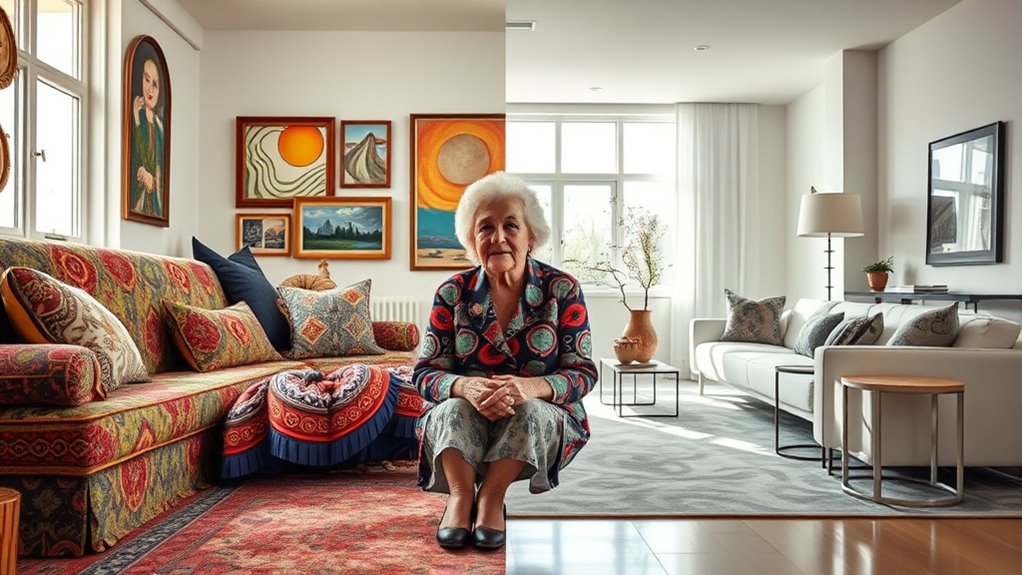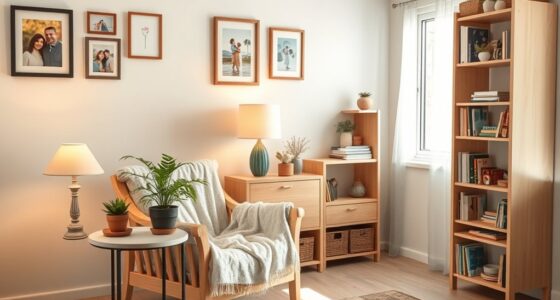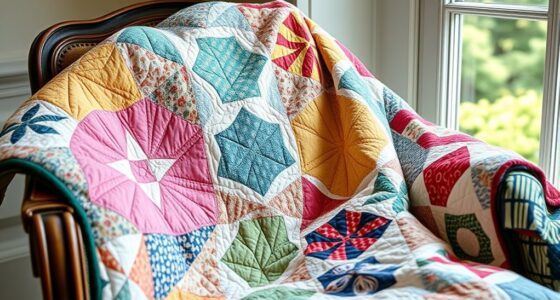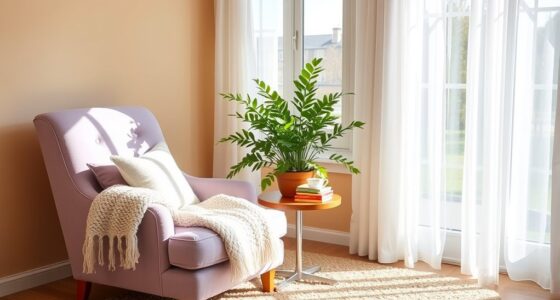Choosing between maximalism and minimalism depends on your personality and needs as a senior. Maximalism lets you express yourself with bold colors and meaningful collectibles, but it can feel overwhelming if not organized. Minimalism offers a calm, uncluttered space that’s safer and easier to maintain. Think about what makes you comfortable and supports your lifestyle. To discover which style best suits your life and home, keep exploring more insight and tips.
Key Takeaways
- Minimalism offers a clutter-free environment, enhancing safety and ease of movement for seniors.
- Maximalism provides a personalized, warm atmosphere but may require careful organization to prevent clutter.
- Minimalist spaces promote tranquility and reduce maintenance, ideal for seniors seeking simplicity.
- Maximalist decor allows for expressive, meaningful items, supporting emotional well-being through personalization.
- The best style depends on individual preferences, physical needs, and lifestyle, balancing safety and personal expression.
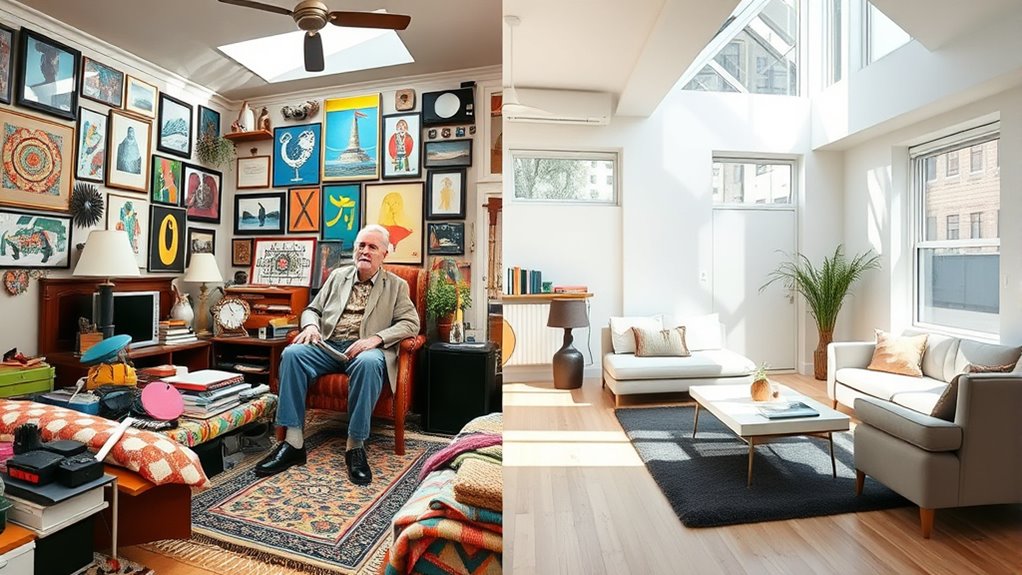
When it comes to design and aesthetics, maximalism and minimalism represent two contrasting philosophies that shape how you experience space and style. If you’re considering how these styles impact your living environment, especially as a senior, understanding their differences can help you choose what feels most comfortable and functional. Maximalism invites you to embrace bold colors, abundant decorative accessories, and layered textures. It’s about creating a rich, personalized space filled with meaningful items that tell your story. This style encourages you to display cherished collectibles, artwork, and vibrant patterns without fear of clutter. However, it’s essential to balance decoration with space optimization so your environment doesn’t feel overwhelming or cramped. Smart use of storage solutions, multifunctional furniture, and thoughtful placement of accessories can keep your space lively yet organized. Maximalism thrives on visual interest, so don’t shy away from mixing patterns or stacking decorative accessories to evoke a cozy, inviting atmosphere.
On the other hand, minimalism emphasizes simplicity and clean lines, making your space feel open, calm, and uncluttered. If you prefer a more streamlined environment, this style reduces visual noise by limiting decorative accessories and focusing on essential, functional pieces. Space optimization becomes vital here because every item should have a purpose, and excess clutter can detract from the tranquil vibe you want to cultivate. Minimalist design encourages you to choose quality over quantity, selecting fewer, well-crafted items that serve multiple purposes. This approach can be especially beneficial for seniors who value ease of movement and safety; fewer objects mean fewer obstacles, and a tidy space can reduce stress. With minimalist decor, you’ll find that open areas promote relaxation and make your living environment feel more spacious. It also allows natural light to flow freely, enhancing the sense of tranquility.
Whether maximalism or minimalism suits you depends on your personality, lifestyle, and physical needs. Maximalism can make your space feel warm and personal, perfect if you love collecting and expressing yourself through decor. Minimalism, however, can provide clarity and ease, ideal if you prefer a serene environment that’s easy to maintain. Both styles have practical implications: maximalism with its decorative accessories can sometimes lead to clutter, while minimalism’s focus on space optimization can make your environment easier to navigate. Incorporating sensory toys or other calming elements can also support emotional well-being in your chosen style. Ultimately, the best style is one that aligns with your comfort and enhances your everyday living. Whichever you choose, making thoughtful decisions about decor and space will guarantee your home remains a sanctuary tailored to your needs.
Frequently Asked Questions
How Can Seniors Effectively Blend Both Styles in Their Homes?
You can blend decorating flexibility and space optimization by mixing elements of both styles. Use minimal furniture to keep the space open and add bold, colorful accents for personality. Incorporate multifunctional pieces that serve multiple purposes, helping you maximize space while expressing your style. This approach allows you to enjoy a lively environment without clutter, making your home both functional and inviting, perfect for your needs.
Are There Health Benefits to Adopting Minimalism or Maximalism?
Imagine your mind as a clear river—flowing smoothly with mental clarity and emotional stability. Adopting minimalism can help you clear clutter, reducing stress and improving focus, while maximalism offers comfort through familiar, cherished items that nurture emotional well-being. Both styles can boost health by creating calming environments, lowering anxiety, and enhancing overall mood. Whether you prefer simplicity or abundance, your home can become a sanctuary for your well-being.
What Are Common Challenges Seniors Face With Each Decorating Style?
You might find that space limitations and mobility challenges make decorating tricky. With maximalism, clutter can overwhelm and cause safety issues, while minimalism’s simplicity helps keep walkways clear. On the other hand, minimalism might feel too sparse or cold, while maximalism could be overwhelming. To stay comfortable and safe, choose a style that balances your space, keeps essentials accessible, and minimizes hazards, ensuring your environment feels welcoming and secure.
How Do Personal Memories Influence Style Choices for Seniors?
Your personal memories strongly influence your style choices, especially through nostalgic decor that reminds you of meaningful moments. You might choose furniture or colors that trigger specific memories, like memory-triggered colors that evoke a sense of comfort or joy. These preferences help you create a space that feels familiar and comforting, allowing you to reconnect with cherished experiences and maintain a sense of identity in your surroundings.
Can Adopting a Style Change Later in Life Impact Emotional Well-Being?
Imagine a butterfly emerging anew—changing style later in life can boost your decorating confidence and enhance style adaptability. It might feel like a fresh start, lifting your spirits and offering a sense of renewal. Embracing new aesthetics can positively impact your emotional well-being, making you feel more vibrant and authentic. So, yes, a style change can be a beautiful, empowering journey that enriches your emotional health.
Conclusion
Ultimately, choosing between maximalism and minimalism is like picking between a vibrant, bustling canvas or a serene, empty one—you get to decide which suits your soul. Don’t let trends dictate your comfort; instead, embrace what makes you feel most at home. After all, your space should reflect you—a masterpiece waiting to be painted with your unique story. So, which style will you choose to make your space truly yours?
